Unit 5: Agriculture and Land Use
1/111
Earn XP
Name | Mastery | Learn | Test | Matching | Spaced |
|---|
No study sessions yet.
112 Terms
a type of farming where the primary goal is to produce enough food for the farmer and their family, rather than for sale or trade.
Subsistence agriculture
the large scale farming of crops and livestock for profit in the marketplace using advanced technologies, mechanization, and extensive land to maximize profit
Commercial agriculture
a farming practice that aims to maximize yields from a given area of land through the use of high levels of inputs, such as labor, fertilizers, and technology. This approach often focuses on smaller plots of land but yields a high output, making it especially effective in regions with high population densities where food demand is greater.
Intensive agriculture
an agricultural practice characterized by low input of labor and capital per unit of land area, typically involving large plots of land and less intensive cultivation methods. This approach often focuses on the production of crops or livestock with relatively low yields but can cover vast areas, making it particularly suitable for regions with abundant land but limited resources.
Extensive agriculture
a farming system that maximizes crop or livestock yield per unit of land by using high inputs of labor, capital, and technology to make a profit (Ex: market farming and dairy farming)
Farming for profit with lots of labor and investment
Intensive-commercial agriculture
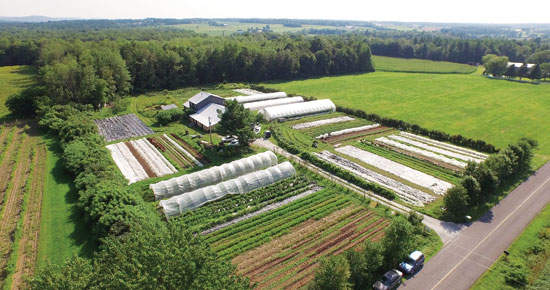
an intensive commercial farming method that involves the intense production of high value crops on a small farm scale, aiming to profit from direct sales to local consumers
Market Gardening
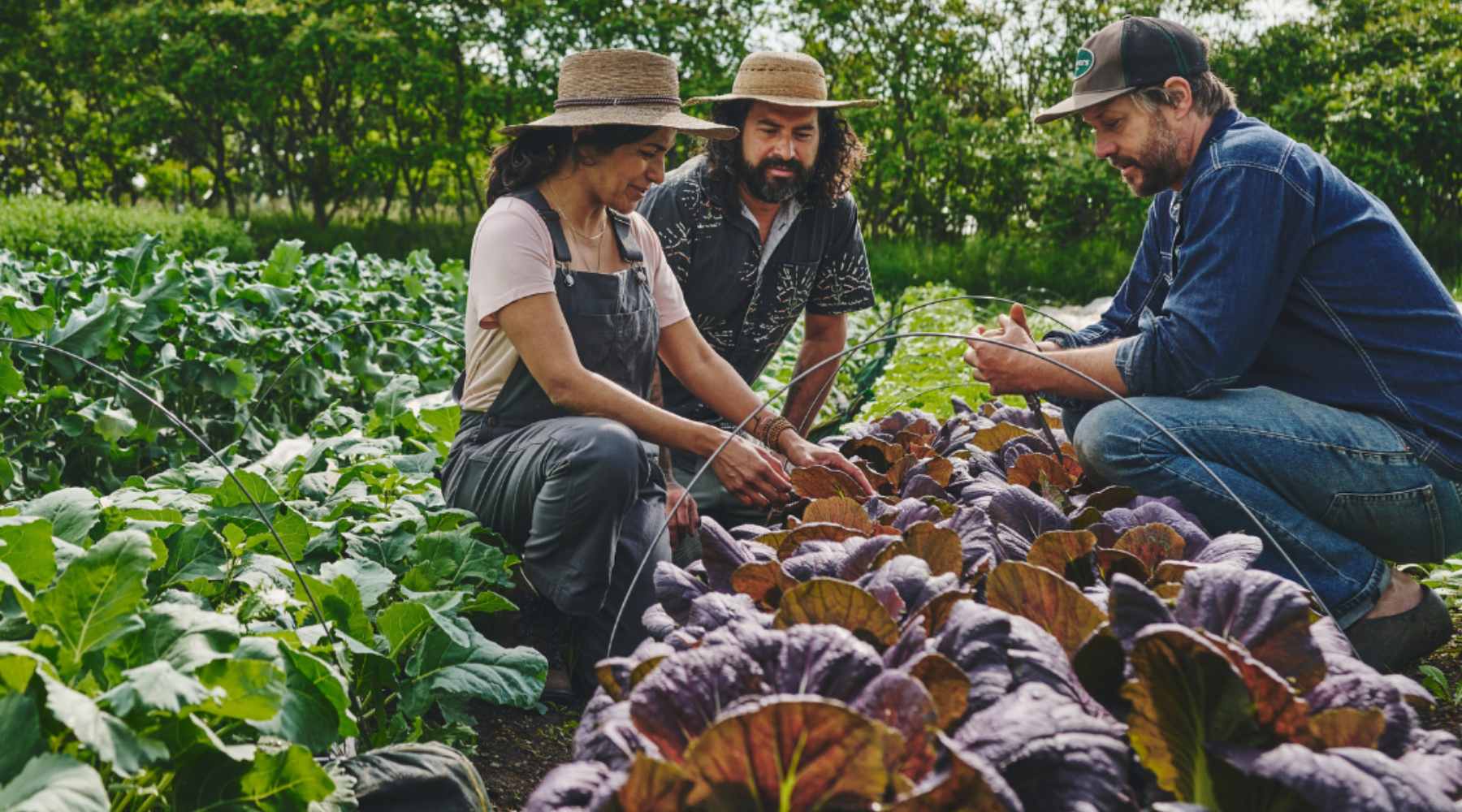
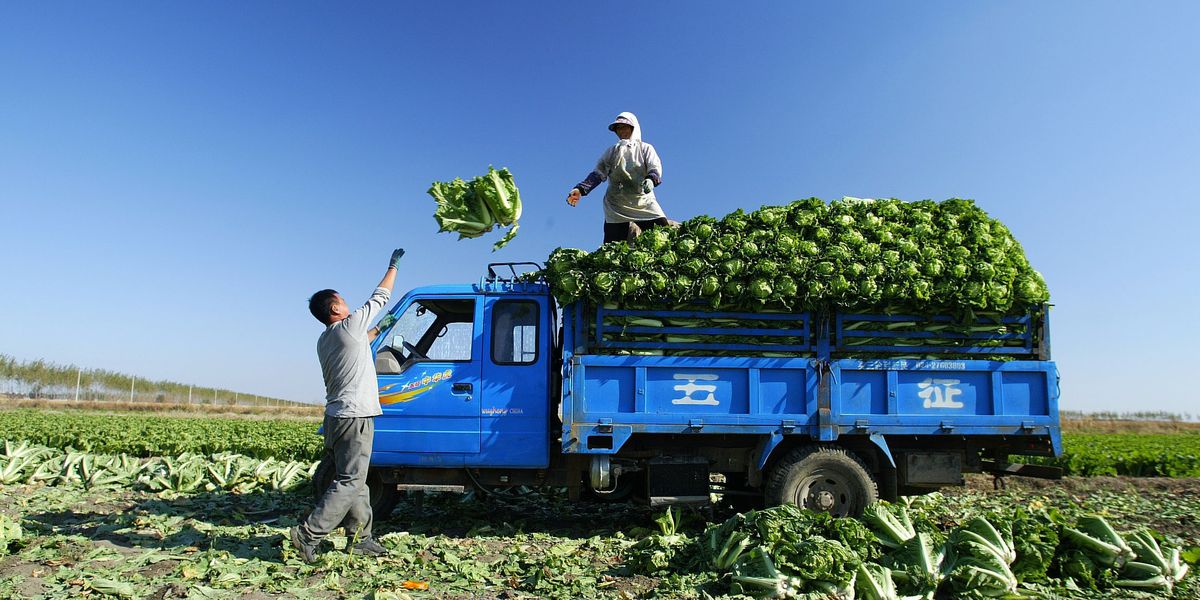
an intensive commercial farming method that involves the large scale production of perishable fruits, vegetables, and flowers on a small farm for sale in nearby or distant markets
Truck farming
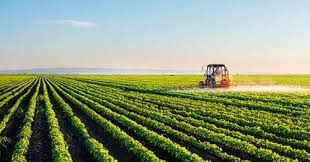
an intensive-commercial farming method that involves the large scale farming system that cultivates a single cash crop, such as coffee, sugar, or rubber, on large estates
Plantation agriculture
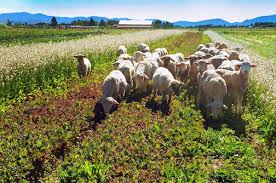
an intensive commercial system that combines the cultivation of crops with the raising of livestock on the same farm
Mixed crops + Livestock
a system of farming that uses a large area of land with low inputs on labor and capital unit per land, focusing on producing goods for sale in the market (Ex: wheat and grain farming in the Great Plains & livestock ranching in Australia)
Farming for profit with minimal amounts of labor and high investment
Extensive-commercial agriculture

an extensive-commercial farming method that involves raising herds of animals on large tracts of land and breeding them
Ranching
a method where farmers use significant labor and inputs on small plots of land to maximize crop yields for their family’s consumption (Ex: wet rice cultivation, crop rotation, and double cropping)
Smaller plots for the community with lots of labor and minimal investment
Intensive-subsistence agriculture
a farming method where farmers use a large area of land to produce just enough food for their family with minimal labor and capital inputs (Ex: Pastoral nomadism, where herders move large herds over vast areas, and shifting cultivation, where a forest is cleared, farmed for a few seasons, and then left to regrow)
Local with minimal amounts of labor and investment
Extensive-subsistence agriculture
a subsistence agricultural practice where farmers clear a patch of land, burn the vegetation, and farm it for a few years before moving to a new location to repeat the process
Small plots of land with lots of labor for community = intensive-subsistence farming method
Shifting Cultivation

a land surveying method that defines property lines using a system of physical landmarks and measurements, such as a specific distance and compass direction from a starting point. It plays an essential role in understanding settlement patterns and land ownership, especially in the context of historical land surveys.
Metes and Bounds
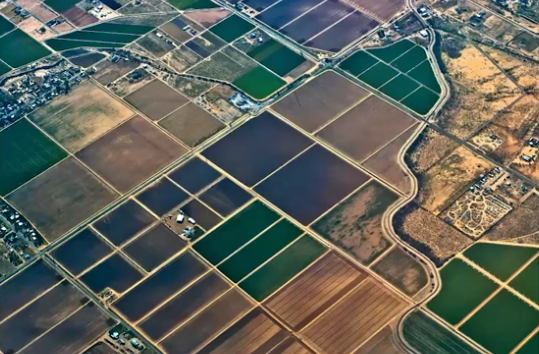
a method of land surveying used in the United States to divide land into a grid of uniform square parcels, primarily in the Midwest and West
Township-Range

a land division system primarily used in French colonial areas, where land parcels are arranged in long, narrow strips that extend from a river or road. This method allows for easy access to water resources and promotes agricultural activities by ensuring that each lot has access to the same natural resources, thereby influencing settlement patterns and land use.
Long-lot
a period of significant agricultural advancement, primarily in Europe from the 17th to 19th centuries, that increased food production and efficiency through new techniques like improved crop rotation, selective breeding, and mechanization. This revolution, which coincided with the Industrial Revolution, resulted in population growth, better diets, longer life expectancies, and a large-scale migration of rural workers to urban centers in search of factory jobs.
Second Agricultural Revolution
a period of major technological advancements in agriculture starting in the mid-20th century. Its key features include the introduction of high-yield crop varieties, chemical fertilizers, pesticides, and modern irrigation techniques to significantly increase food production
Green Revolution/Third Agricultural Revolution

an economic model that explains how the price and demand for real estate change as the distance from the central business district increases. It highlights how different land users will compete for space in urban areas, with those who are willing to pay more for proximity to the center being located there, while others settle further away.
Bid-rent Theory
the practice of harvesting two crops from the same field in a single growing season to increase productivity (Note: the second crop is grown after the first crop is harvested)
Double Cropping
an agricultural practice where two or more crops are grown together in the same field during a growing season. (Note: both crops are grown simultaneously)
Intercropping/Multicropping
the agricultural practice of growing a single crop species in a given area for multiple seasons. This could be done to make it a commodity so more money could be made off of it.
Monoculture
concentrated areas where livestock are confined and fed high-energy grain diets for rapid growth before slaughter
Feed Lots
the ability of a country to produce a good or service at a lower opportunity cost than another country. This concept emphasizes that trade can be beneficial, as it allows nations to produce what they are most efficient at, thus enhancing overall economic welfare. By focusing on their comparative advantages, countries can trade and gain access to a wider variety of goods and services.
Comparative Advantage
an industrialized form of agriculture that focuses on maximizing production by using intensive methods and technology to raise livestock in confined spaces. This approach often prioritizes efficiency and profit over animal welfare, leading to practices that can significantly impact the environment, public health, and rural economies.
Factory Farming
a business strategy where a company controls multiple stages of a product's production and distribution process, from raw materials to the final sale
Vertical Integration
the cost advantages that businesses experience as they increase their production levels. As firms produce more goods, the average cost per unit tends to decrease due to the spreading of fixed costs over a larger number of units and operational efficiencies. This concept is crucial in understanding how companies can become more competitive in the global market and how it affects economic growth and development.
Economies of scale
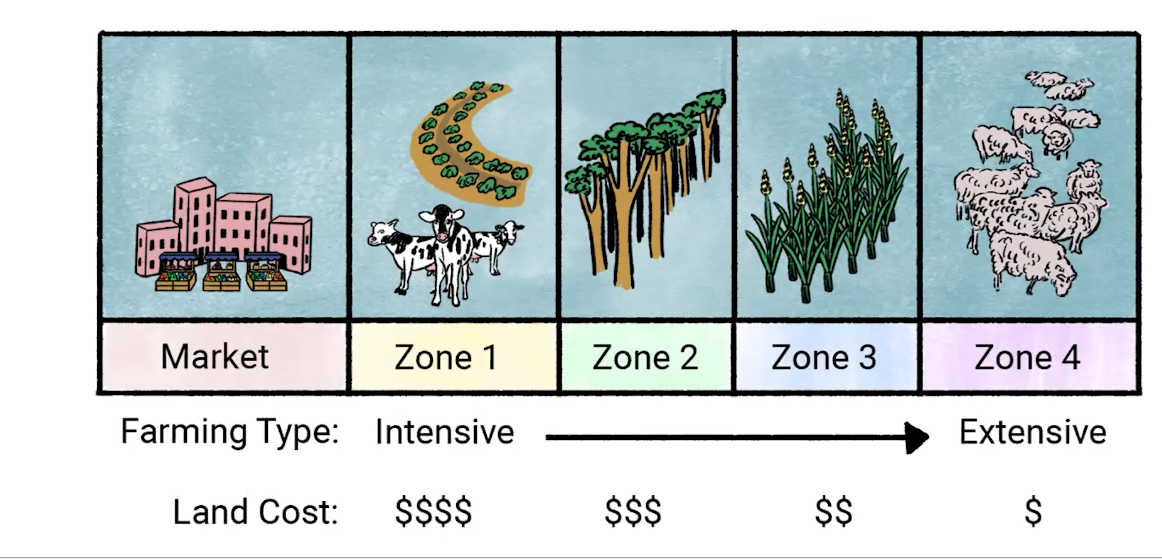
an economic model that explains how commercial agriculture is spatially organized around a central market. It suggests that the type of agriculture in a location is determined by its distance to the market, with land use patterns based on land costs, transportation costs, and the perishability of goods.
Von Thunen Model
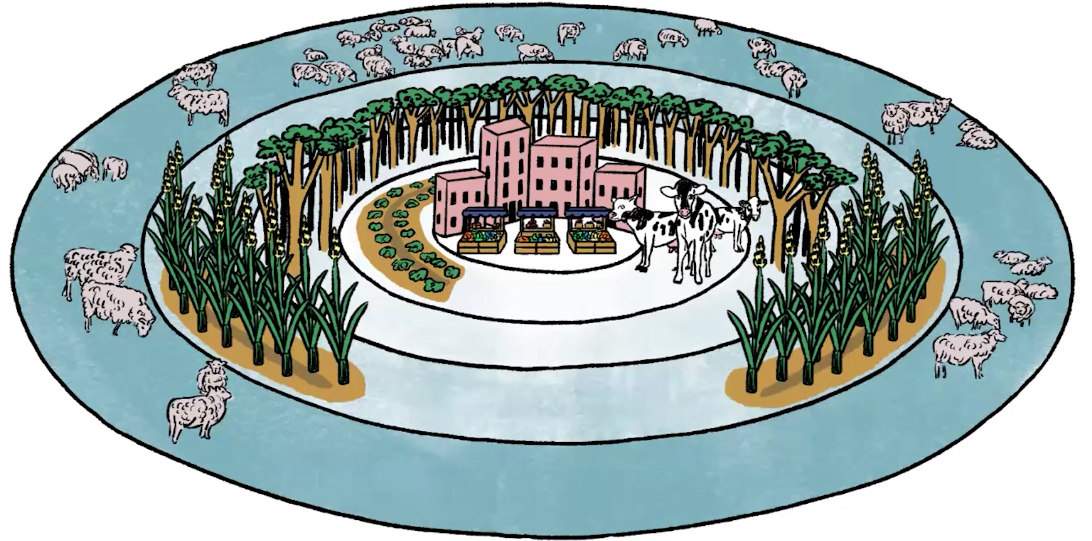
Necolonialism
a consumer-driven, global initiative that promotes fair wages, safe working conditions, and community development for farmers and artisans in developing nations
Fair Trade Movement
the integrated system of agricultural production, processing, distribution, and marketing that encompasses a wide range of activities like seed development to production, processing, distribution, and retailing
Agribusiness
the process where fertile land in dry or semi-arid regions becomes degraded and desert-like due to factors like climate change and human activities such as overgrazing, deforestation, and unsustainable farming
Desertification

a modern agricultural technique that uses a long, rotating pipe on wheels to water crops in a large circular pattern from a central point, often visible from space
Center-pivot irrigation
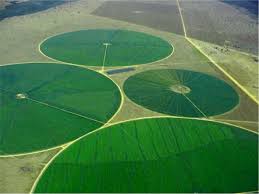
a direct marketing model where consumers buy "shares" of a farm's harvest in advance, sharing the risks and benefits of food production with the farmer. This system creates a close connection between producers and consumers, often fostering local economies, promoting sustainable practices, and contributing to food security by emphasizing local and seasonal food systems.
Community Supported Agriculture (CSA)
the lack of consistent access to enough food for an active, healthy life
Food insecurity
a geographical area with limited access to affordable and nutritious food, often due to a combination of physical and economic barriers
Food desert
a tax imposed by a government on imported goods to raise their price, encouraging domestic consumption and protecting local industries
Tarriff
As a result of the Columbian Exchange, which crop was transferred from the Americas to Europe and later spread through the world?
Maize (corn)
An agricultural hearth is a location where
plants and animals were first domesticated
In which state or province is the long-lot land division most common?
Quebec
Mediterranean agricultural products are most commonly grown in
Southern Spain and California
Which of the following best explains the potential impact of rising global temperatures on agricultural regions?
The wheat belt will shift northward.
Which of the following best explains the importance of climate to agricultural practices?
Midlatitude climates tend to support similar agricultural crops and practices, such as wheat farming in the United States and China.
Sheep production in New Zealand and poultry production in Arkansas produce food animals for human consumption. Which of the following best describes the differences in the agricultural practices and land use for these products?
Sheep production is an example of extensive agriculture requiring large pastures, whereas poultry production is an example of intensive agriculture often practiced indoors.

Which of the following best explains the reasons for the similarities and differences between the two land survey systems shown?
Both systems require geometric calculations to survey property lines. However, the township-and-range system uses simplified calculation to create a more ordered landscape.
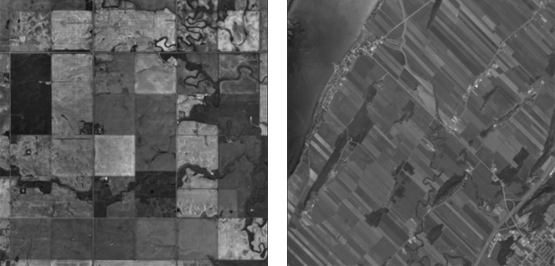
Which of the following best explains the differences between the patterns of land use in the township-and-range system and the long-lot system, as shown in the images?
The township-and-range survey system was based on a geometric grid pattern, while the long-lot system was a rectilinear pattern based upon waterways or roads.

The two images represent different agricultural land survey patterns. Comparing the two images, which survey system was more efficient in terms of trade?
The river in the long lot survey system provided better access to waterways to transport goods to market.
Which of the following explains why multiple early hearths of domestication and diffusion of plants and animals arose across the world in Central America, the Fertile Crescent, the Indus River valley, and Southeast Asia?
Domestication of plants and animals evolved in each hearth independently of one another as societies in each area learned and applied the process to local plants and animals.
Which of the following best explains the diffusion of plants and animals from their hearths of domestication?
Both domesticated plants and animals spread across the globe through contagious diffusion in early years by farmers and traders, and later by relocation diffusion through European exploration and colonialism.
Which of the following explains the diffusion and successful cultivation of many plants and animals in new regions of the world through the Columbian Exchange?
The plants and animals diffused to a region with climate and geography similar to that of their point of domestication.
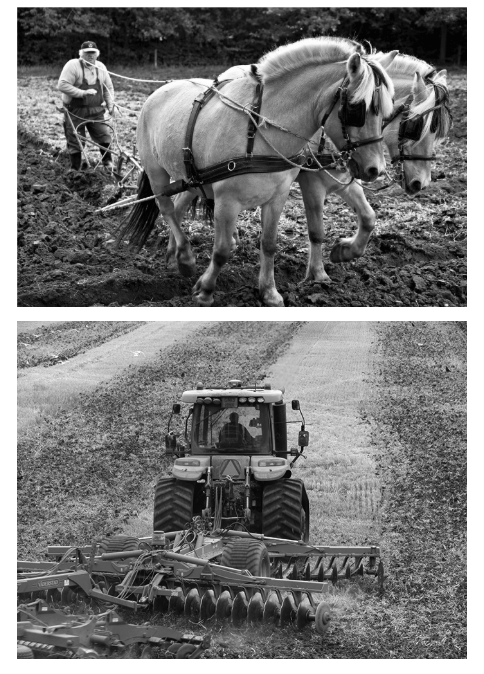
The two images show different agricultural methods. In the context of the Second Agricultural Revolution, which of the following trends is represented in these images?
The mechanization of farming in the Second Agricultural Revolution resulted in more reliable crop harvests and healthier populations in areas where the mechanization was adopted.
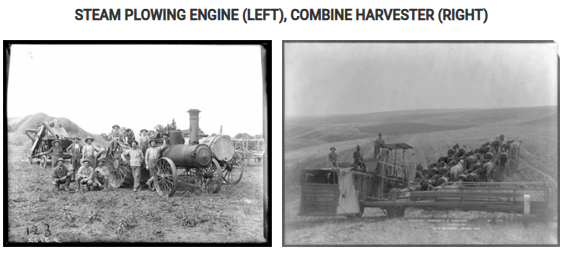
The images show devices developed during the Second Agricultural Revolution. Which of the following best describes the impacts of the Second Agricultural Revolution?
Technological innovations, such as the devices shown in the images, and increased agricultural productivity led to better diets, longer life expectancies, and more people available for work in factories.
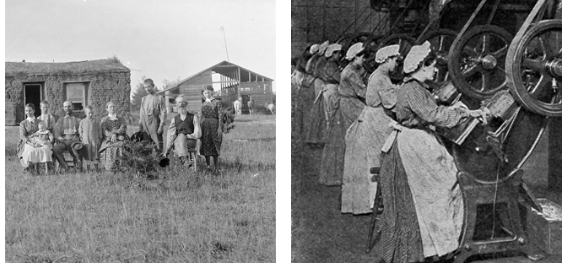
The images shown illustrate a change that took place as the Second Agricultural Revolution coincided with the Industrial Revolution. Which of the following compares this geographic relationship between these revolutions?
The mechanization of farm work allowed many young people to migrate and join a growing urban industrial workforce
Which of the following best explains why farmers would plant both strawberries and watermelons in the same field?
Limited farmland encourages intensive farming with intercropping to produce high yields.
Which of the following spatial patterns is best explained by bid-rent theory?
Concentric rings of different agricultural activities surrounding a city in the midwestern United States
In the South Asian country of Sri Lanka, tea is farmed as a monoculture. Which of the following best explains why tea plantations are common in Sri Lanka and tea exports are important to the country's economy?
Tea plantations were established in Sri Lanka by a former European colonial power.
Why have many family farms in North America been replaced by agribusiness farms since the 1980s?
Agribusiness farms have the resources to take advantage of economies of scale.
Which of the following explains the role of commodity chains in the average size of farms?
Commodity chains have led to changes in the spatial organization of agriculture from dispersed family farms to large corporate farms that produce, process, and distribute the products.
Which of the following is an explanation for the similar impact of large-scale commercial agriculture in developed countries and plantation agriculture in developing countries?
Both farming practices involve the consolidation of family farms and displacement of rural communities.
Based on von Thünen’s model of rural land use in an isolated state, which statement explains the most suitable place for a farmer to purchase a large parcel of land necessary for raising livestock?
The ring farthest from the market, because the land is less expensive and outweighs transportation costs to get the livestock to market.

Based on the diagram of von Thünen’s model of agricultural land use, which statement best explains the connection between land value and agricultural production regions?
Grain crops require extensive acreage and are grown on land that is less costly and farther away from the market than other agricultural land uses.
Which of the following correctly explains the placement of an agricultural product within von Thünen’s agricultural land-use model?
Tomatoes are grown closest to the market because they spoil quicker than beef or grain.
Palm oil, an edible vegetable oil used in processing packaged food products, is obtained from the fruit of the oil palm tree, grown only in the tropics. Which of the following explains how global demand for palm oil has proved beneficial and detrimental for countries such as Indonesia and Malaysia?
Palm oil exports provided substantial corporate profits, but the growth in the industry resulted in heavy deforestation in both countries.
Which of the following explains an impact of globalized agricultural commodity chains on consumers as compared to producers?
Drought and depletion of groundwater sources in developing countries cause a rise in global grain prices and associated higher costs for food.
Which of the following best explains why the New England region, located in the northeastern United States, would specialize in market gardening agriculture rather than other types of agriculture, such as grain farming?
Several large cities on the East Coast provide a growing market and shorter distances for transporting market gardening products.
Which of the following agricultural practices has the most significant long-term environmental impact in tropical regions?
Burning extensive areas of forested land to create pasture, which decreases biodiversity
Which of the following best explains how the expansion of feedlots for raising cattle has affected environmental sustainability in rural areas?
Runoff from animal waste has increased the pollution in local water supplies.
Which of the following social or environmental impacts is most directly related to the use of chemicals in agriculture?
An increase in land and water pollution from agricultural runoff
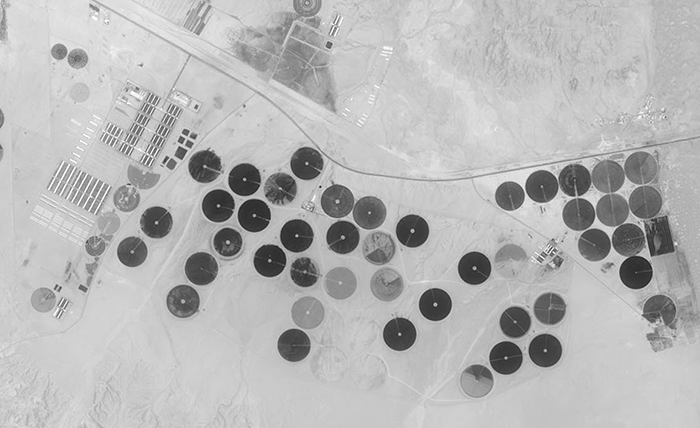
Based on the different types of land use shown in the image, which of the following best explains why soil salinization is a concern in the arid landscape shown?
Irrigation increases the salt content of the soil, which disrupts the growth of crops and degrades soil fertility.
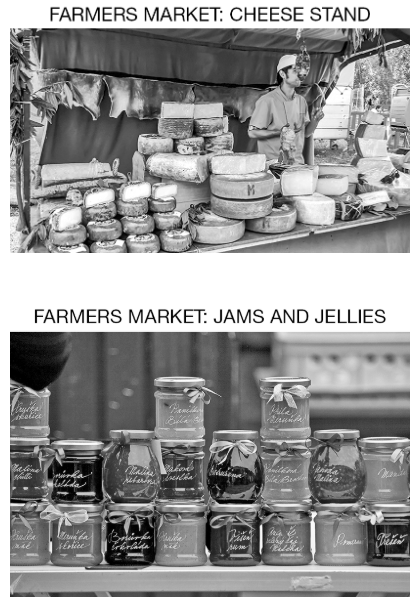
Which of the following best explains the economic advantage of the type of farm-produced goods shown in the images?
Compared to plain milk or fresh fruit, these value-added agricultural goods significantly increase the price of the farm products sold and increase earnings for farmers.
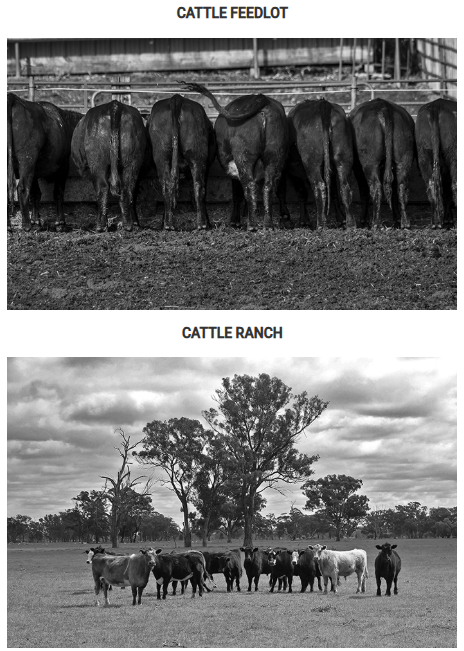
The two images represent two different methods of raising livestock in the United States. Which of the following statements most accurately compares these two agricultural practices?
Feedlots can minimize costs associated with livestock production because feedlots do not use as much space as cattle ranching.
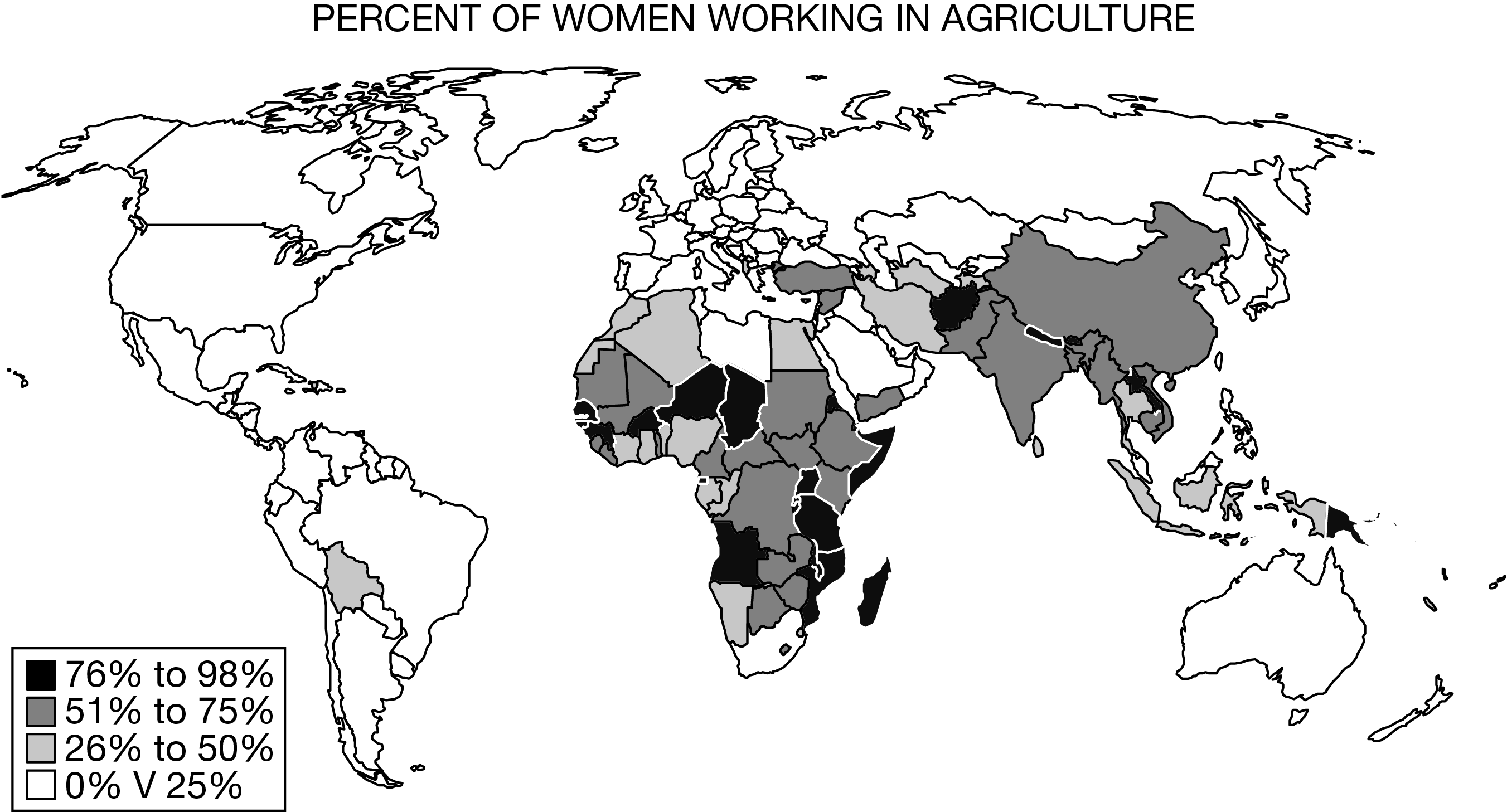
Based on the map, which of the following explains the similarities of the world regions where at least 51 percent of women work in agriculture?
These regions are composed of less-developed countries with large rural populations.
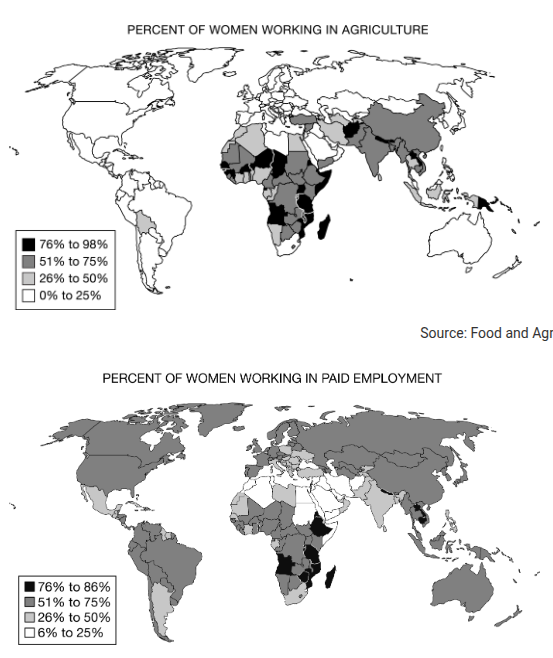
Compare the two maps and examine the data for Africa, the Middle East, and South Asia. Which of the following statements is supported by the comparison of the two maps?
Many women in these regions work on farms and grow food for their families, but not all are paid to do this work.
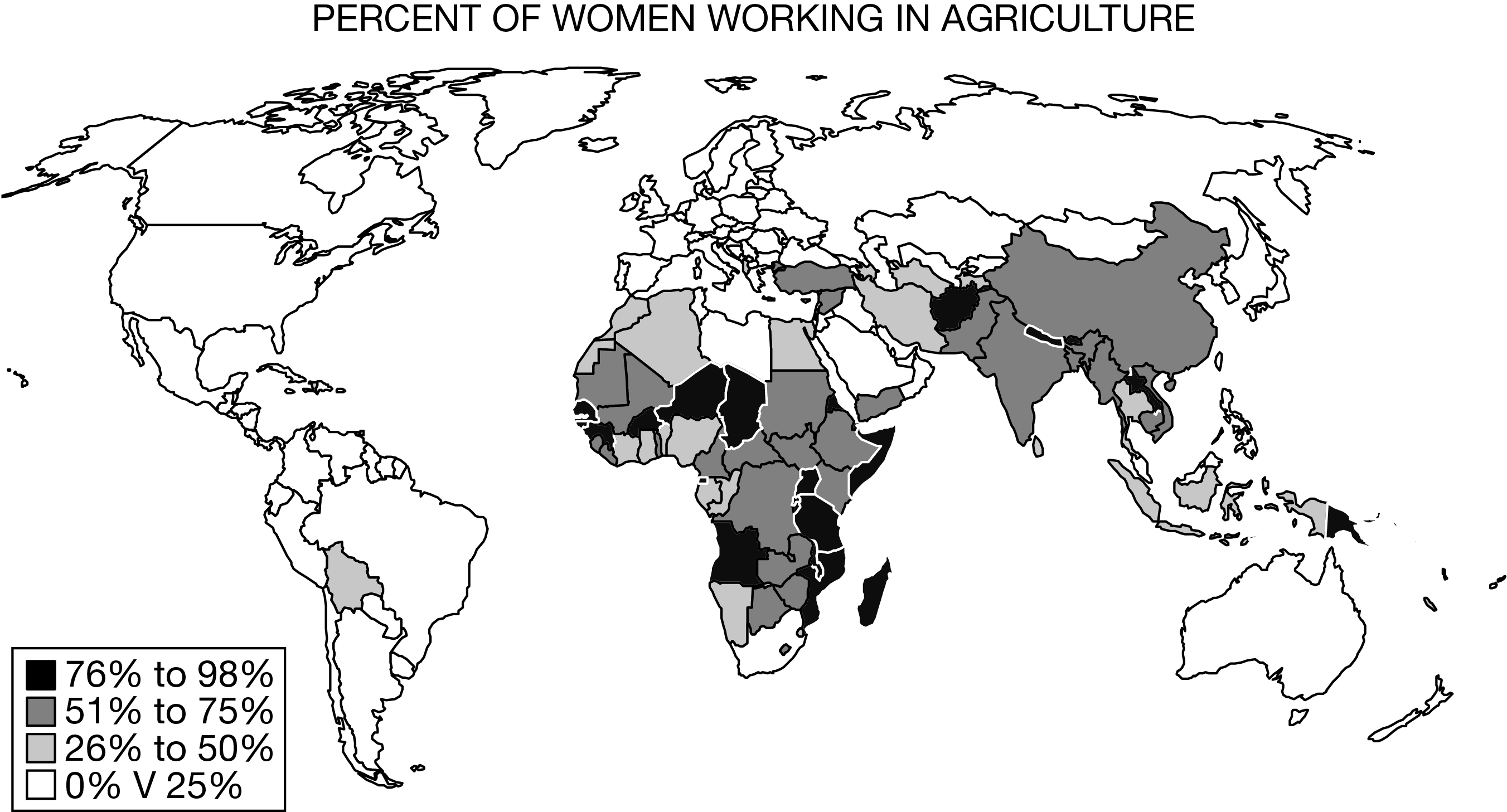
Which of the following explains the significance of the similarities between Asia and sub-Saharan Africa in terms of the percent of women working agriculture?
In the subsistence-based rural economies in these regions, female farmers produce much of the food that their families need for survival.
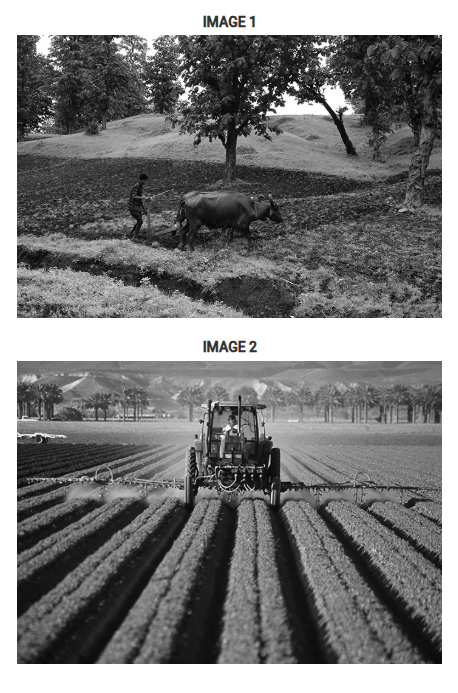
The images show examples of agricultural technology developed during different time periods. Which of the following statements is best supported by the images?
Image 2 shows an innovation that occurred in the Second Agricultural Revolution, reducing the amount of labor needed and increasing crop yields.
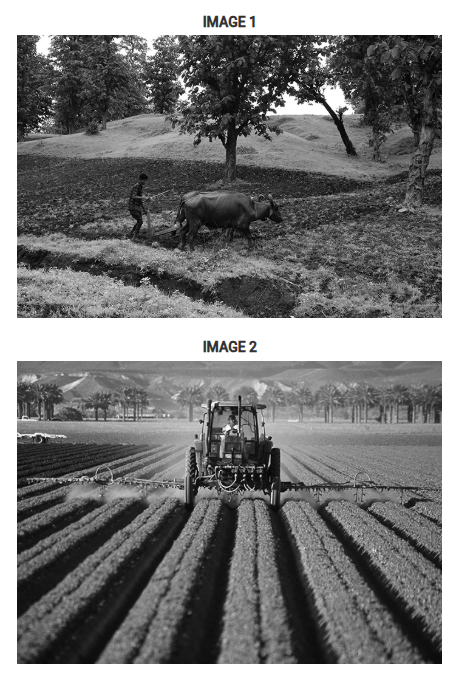
Which of the following correctly compares the significance of the different technologies shown in the images?
Invention of the plow eased the intensive use of labor, and the innovation of mechanized farm equipment led to improved food production.
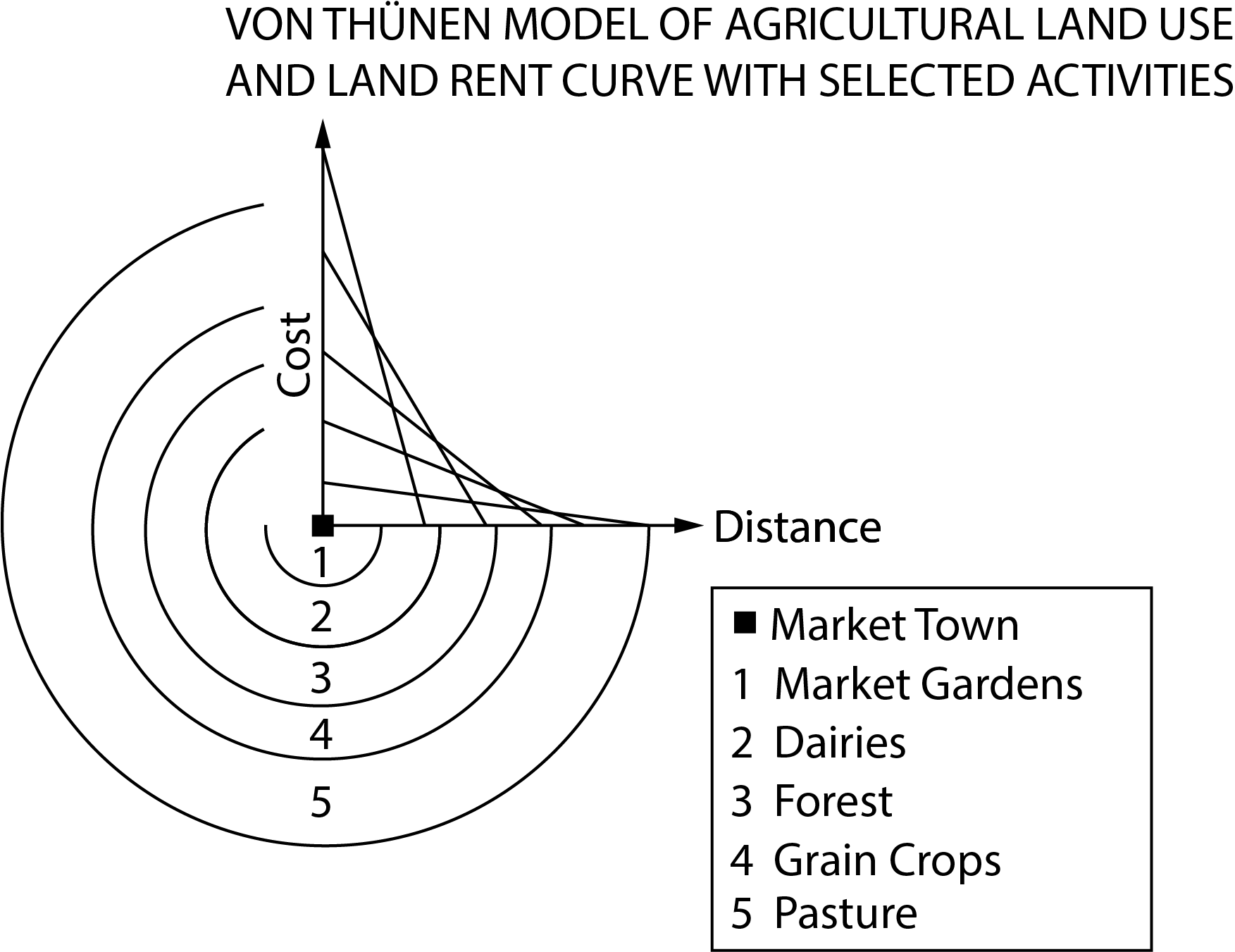
Which of the following best explains the spatial patterns illustrated in von Thünen’s model?
Labor-intensive farming of vegetables is done in small-scale plots in market gardens, while extensive grain crops are grown in large-scale fields far from the market town.

Which of the following best explains why in the model the amount of land used for dairying is much smaller than the pasture used for beef cattle?
Dairy cows must be kept close to farmhouses, as they require daily milking, and milk must be produced close to consumers, as it is highly perishable.
A typical grocery store in the United States may sell oranges grown primarily in California during part of the year and oranges grown primarily in South Africa during a different part of the year. Which of the following explains why oranges are available year-round in the United States?
Grocery stores sell oranges that are grown in locations with similar climates but different growing seasons.
Which of the following best explains the significance of a similarity among locations where olives, figs, grapes and lemons are grown?
Intensive agriculture is practiced in a Mediterranean climate.
Which of the following best explains the significance of similarities between the farming practices for apple orchards and grape vineyards?
Both farming practices require considerable labor input because the fruit is picked by hand, making it a product of intensive agriculture.
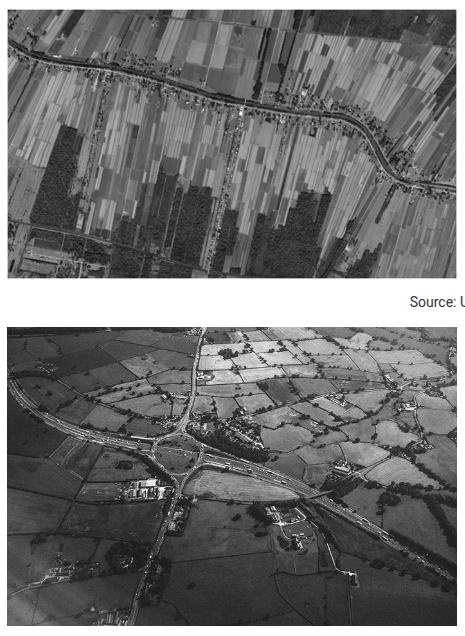
Agricultural settlement patterns are partly determined by the survey system used to organize landownership. Which of the following best describes the survey methods used to delineate agricultural land and the associated settlement patterns shown in the two images?
The first image shows a long-lot survey method with a linear settlement pattern, and the second image shows a metes-and- bounds survey method with a dispersed settlement pattern.
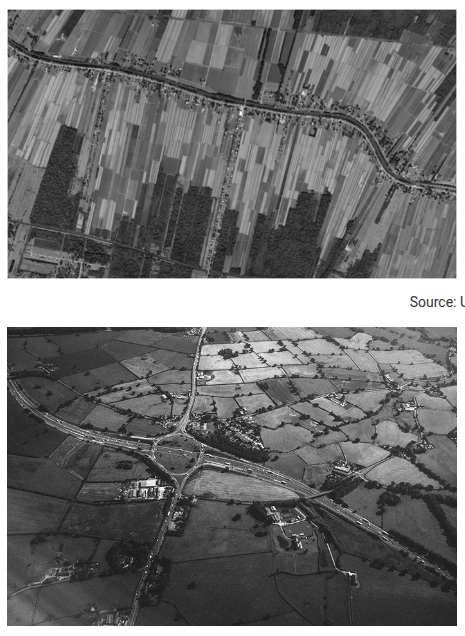
The long-lot system results in population clustered along a waterway, whereas the metes-and-bounds system results in a random, dispersed population pattern.
The long-lot system results in population clustered along a waterway, whereas the metes-and-bounds system results in a random, dispersed population pattern.
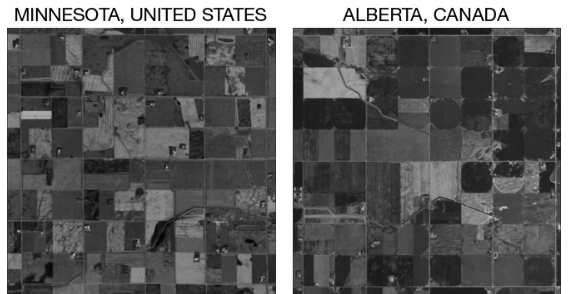
Which of the following best describes the survey system used in both locations shown?
Township and range: unit-block field patterns with dispersed farmsteads and occasional villages
Which of the following correctly explains the relationship between wheat and its early hearth of domestication?
Wheat was first domesticated in Mesopotamia because of a favorable climate and a great diversity of wild grains that led to crossbreeding of seeds.
Which of the following scenarios best explains the Columbian Exchange?
Domesticated animals such as cattle, horses, pigs, and chickens were introduced to the Americas by European colonizers. Prior to this, very few animals had been domesticated in the Americas.
Which of the following explains the prevalence of banana plantations in Central America?
Banana plants were brought to Central America from Southeast Asia to be grown closer to markets in the United States and Canada.
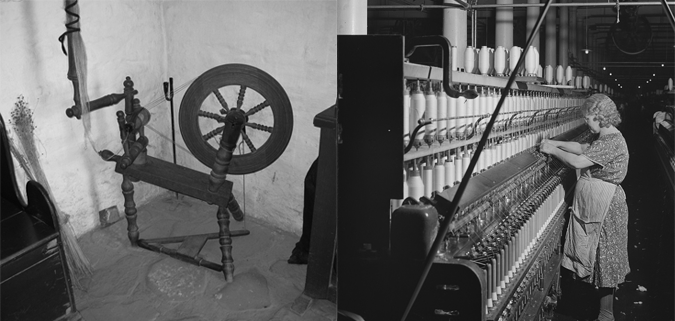
The images shown illustrate the differences in scale of production for two methods of producing thread. Which of the following best describes advances in the production of textiles during the Second Agricultural Revolution and the Industrial Revolution?
The conversion from manual thread spinning to an industrial processing approach led to increased demand for raw cotton in the agricultural sector.
The Green Revolution led to an increase in food production in many places around the world, but there have been some negative consequences. Which of the following explains one of the negative consequences of the Green Revolution that would be of greater concern for people in developing countries than for people in more-developed countries?
Runoff of agricultural chemicals into the local groundwater that pollutes water resources
Which of the following best explains a negative economic consequence of the Green Revolution in less developed countries as compared to more developed countries?
Because of the increased capital investment required to produce new crop varieties using technology that was pioneered in more developed countries, there was an increase in wealth disparity in many farming communities in less developed countries.
Which of the following best compares a technological consequence of the Green Revolution in more developed and less developed countries?
Farmers in less developed countries were able to increase their profits from growing and exporting high-yield grain to levels similar to those in more developed countries.
Which of the following best explains how a wheat farmer in the Northern Plains region of the United States is able to maximize profits?
Grain farming is an extensive farming practice that can maximize profits in part by lower land costs, lower transportation costs, and imperishability of the product.
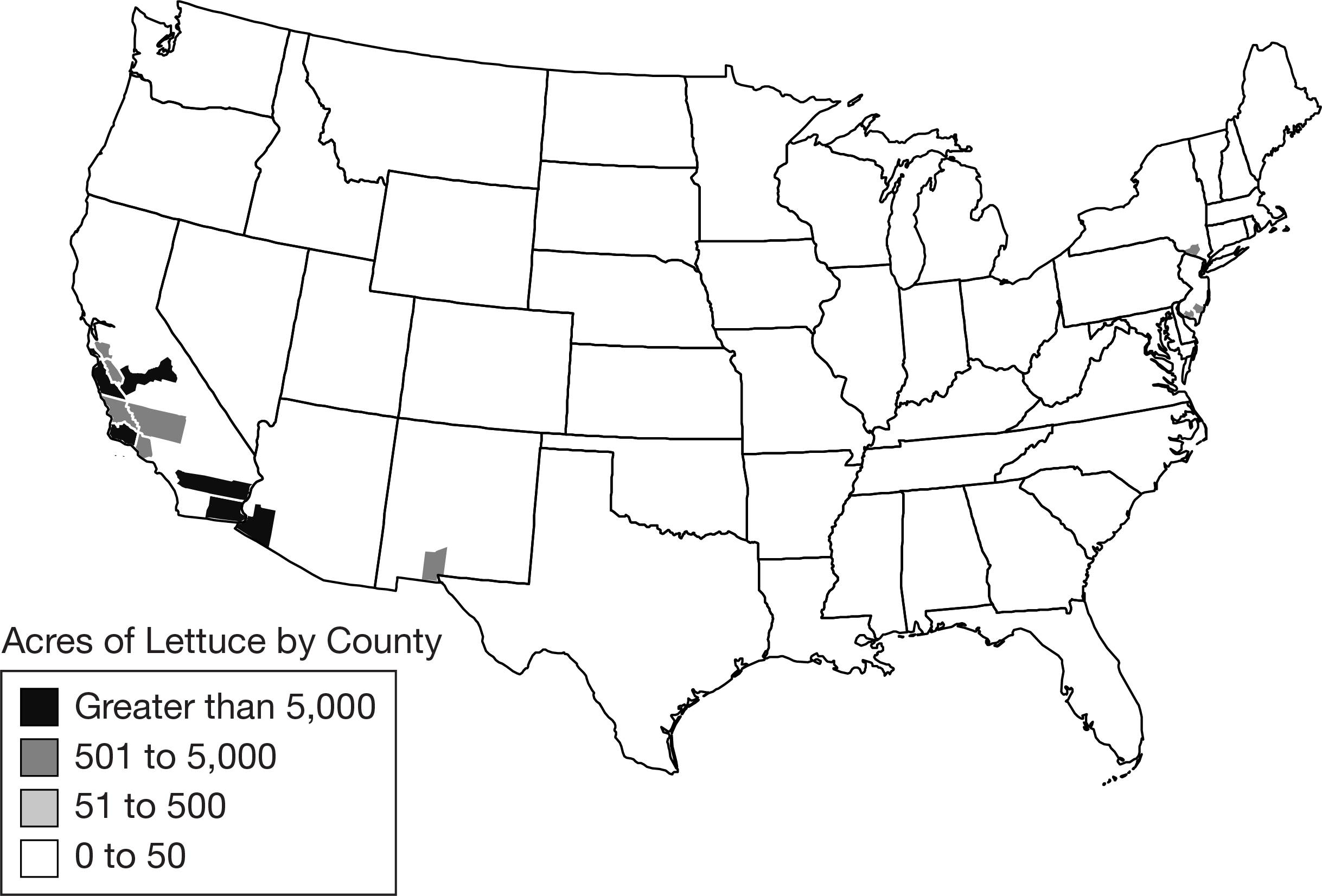
Based on the map above, explain the degree to which lettuce production takes place in the United States
Lettuce production in the United States is an example of commercial farming. Most lettuce is produced, processed, and packaged for sale in supermarkets that are a significant distance from where the product was grown.
Which of the following best explains the farming practice related to plantation agriculture?
Plantation farming is considered to be an intensive farming practice because it requires large inputs of labor and capital to produce the crop.
Which of the following explains an economic benefit of cattle production using feedlots rather than grass pastures?
Agricultural technology has increased the economy of scale and the carrying capacity of feedlots, increasing profits for the farmer.
Since the mid-twentieth century, wheat production has risen dramatically in some regions of the world but not others, which may increase the uneven development among countries. Which statement best explains the increase in wheat production in Europe and the United States compared to sub-Saharan Africa?
Farmers in Europe and the United States use high-yield seeds and other technology but farmers in sub-Saharan Africa depend on low levels of mechanization and non-genetically modified seeds.
More developed countries tend to have greater access to agricultural technology and government-supported loans used to purchase computerized farm equipment. Which of the following best explains the significance of access to these resources?
Government financing and improved technology lead to larger economies of scale and improved efficiency.
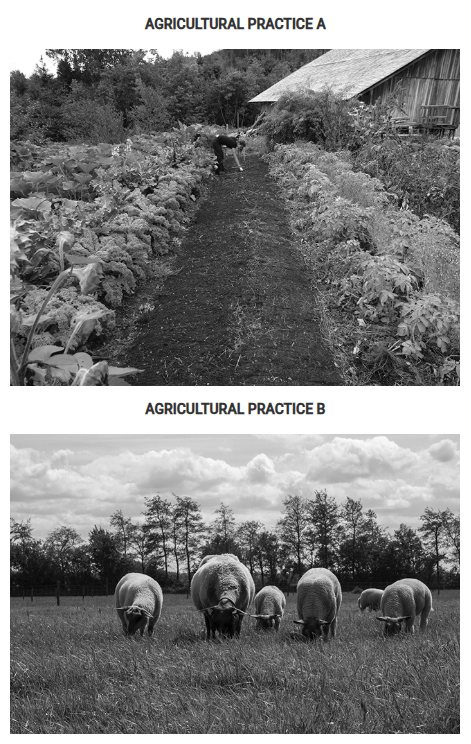
Based on von Thünen’s model of rural land use, which of the following explains the location of agricultural practice A or B relative to the market?
Practice A represents intensive land use, requires a smaller parcel of land, and can afford higher land costs found closer to the market.